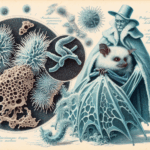What stops matter from collapsing into a chaotic soup of electrons and nuclei? Why do atoms behave as they do, forming everything from diamonds to DNA? And why hasn’t reality disintegrated into a shimmering haze of undifferentiated energy?
Physicists in the late 19th century had no idea. Dmitri Mendeleev’s periodic table was a neat trick, but it didn’t explain why elements behaved in strangely predictable ways. Then, in a twist fit for a sci-fi thriller, J. J. Thomson discovered that atoms contained tiny, negatively charged particles—electrons. Reality, it turned out, wasn’t just neat columns on a chart; it had structure, forces, and secrets still to be uncovered.
Enter Ernest Rutherford in 1911, who promptly shattered any lingering illusions of simplicity by revealing the atomic nucleus. A dense, positively charged core sat at the heart of every atom, surrounded by buzzing electrons. But there was a problem: classical physics had no way to explain why these electrons didn’t simply spiral inward and annihilate the universe as we know it.
A Rule That Keeps Everything from Falling Apart
The answer arrived in 1925, courtesy of a 24-year-old Austrian physicist with a sharp mind and, reportedly, a sharp tongue: Wolfgang Pauli. He proposed a principle so radical it rewrote the fundamentals of atomic structure. The Pauli exclusion principle declared that no two electrons in an atom could occupy the same quantum state.
This was more than just a quirky rule—it was the reason the periodic table worked, why atoms had structure, and why matter itself wasn’t a collapsing pile of indistinguishable particles. It dictated electron arrangement, explaining why materials had different properties: why some conducted electricity, some didn’t, and some—like diamonds—were absurdly strong.
Quantum Chaos and Order
Pauli’s idea came from the strange, half-formed world of early quantum theory. At the time, physics was a collection of brilliant but disconnected insights. Max Planck had introduced the idea of quantized energy in 1900 to explain blackbody radiation, and Niels Bohr had built a model of the atom where electrons occupied specific energy levels. But none of it quite explained why elements behaved so consistently.
Pauli’s principle provided the missing piece. It imposed order on quantum chaos, ensuring that electrons filled energy levels in a predictable way. This, in turn, dictated how atoms bonded, forming the intricate chemistry that makes up everything from the air you breathe to the screen you’re reading this on.
A Rule That Survived the Quantum Revolution
Many early quantum ideas were discarded as the field evolved, but Pauli’s exclusion principle survived. When Werner Heisenberg, Erwin Schrödinger, and Paul Dirac built the full framework of quantum mechanics in the late 1920s, they found that Pauli’s rule wasn’t just useful—it was fundamental. It explained why white dwarf stars didn’t collapse under their own gravity and why neutron stars, the densest objects in the universe outside of black holes, could exist at all.
Without it, electrons would pile into the lowest energy states, atoms would collapse, and chemistry—along with reality as we know it—would cease to function. The universe, it turns out, runs on strict rules, and Pauli’s principle is one of the most important.
Five Fast Facts
- Wolfgang Pauli was infamous for his scathing critiques of bad physics, once dismissing a paper as “not even wrong.”
- The Pauli exclusion principle explains why neutron stars—so dense that a sugar-cube-sized chunk would weigh billions of tons—don’t implode.
- Niels Bohr’s early atomic model worked well for hydrogen but failed for more complex elements, forcing the search for a better quantum theory.
- J. J. Thomson, who discovered the electron, originally thought atoms were like “plum pudding,” with electrons scattered like raisins in a positively charged dough.
- Dmitri Mendeleev predicted the existence of several elements before they were discovered, including gallium and germanium.





